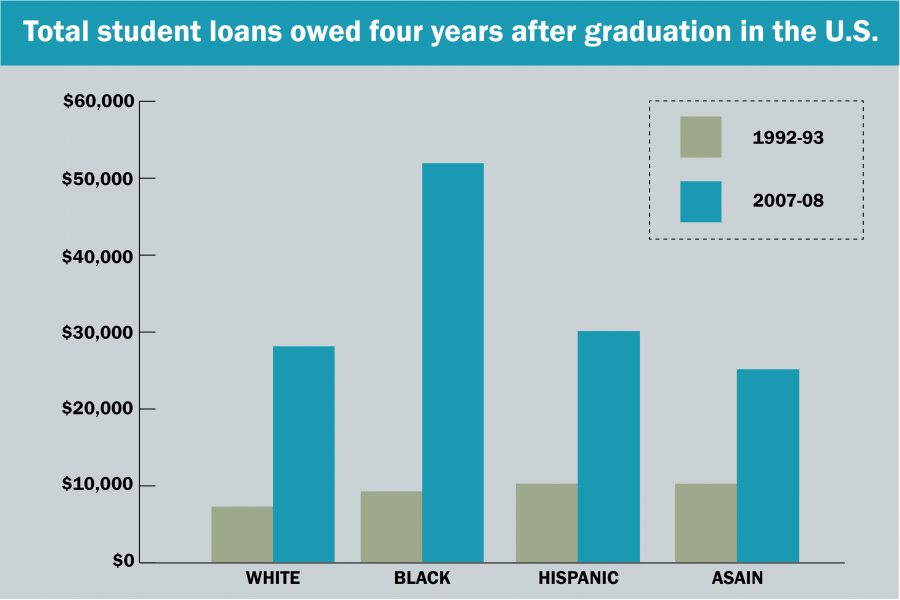Black students owe twice the amount of student loan debt white students do four years after graduation, according to a report released by the Brookings Institution.
The Brookings report analyzed data from the Department of Education and the Census Bureau to compare different racial groups that finished their undergraduate degrees in 1993 and compared it to those who finished in 2008. The report focused on the gap between student debt taken on by whites and blacks four years after graduation, the two groups with the least and most debt, respectively.
Student debt grew across the board for all racial groups when comparing the 1993 group to the 2008 group, however the gap for student debt four years after graduation between blacks and whites grew to nearly $25,000, nearly triple the gap right after graduation in 2008, with black graduates on average coming out with $52,726 in debt while white graduates had $28,006 in debt.
Judith Scott-Clayton, an economics and education associate professor at Columbia University who co-authored the report, said she was surprised when she saw how large the racial disparity gap had grown.
“I knew from prior research that there were racial disparities in borrowing, but I was shocked when we realized how much they grow after graduation,” Scott-Clayton wrote in an email. “It’s not just the fact that a gap exists, but the magnitude. It made me wonder how different the policy conversation, and some of my own thinking on the topic of student loans, would be different if the national averages were the same as the African-American averages.”
The report states the biggest reason for the gap comes from the higher percentage of black students who enroll in graduate school. Forty-seven percent of black students who graduated in 2008 went on to graduate school, versus 38 percent for whites during that same period. While the authors of the report consider graduate school a good investment because of higher average earnings, blacks with graduate degrees still earn on average less than whites with only a bachelor’s degree.
According to the report, loan repayment plans tied to income — such as the Revised Pay-As-You-Earn plan, which caps loan payments to 10 percent of monthly income and provides loan-forgiveness after 20-25 years — in theory can help borrowers of any race manage their debt.
“[Income-based repayment] plans will not lower the nation’s student loan debt, but they do make paying back the money owed to the federal government potentially easier,” UT economics assistant professor Richard Murphy wrote in an email.
However, while these plans may alleviate some consequences of the racial debt disparity, they neglect to address the underlying causes, according to the report. It also notes that federal financial aid policy won’t be enough to combat the growing racial disparity, and it can’t ignore the challenges students of color face.
Currently, neither the Free Application for Federal Student Aid nor the National Student Loan Data System, which tracks debt repayment, accounts for race in their data. Most of the data gathered for the report was through surveys conducted by the Department of Education every four years.
“UT Financial Aid doesn’t track demographic data,” Joey Williams, UT interim communications director for the office of the executive vice president and provost, wrote in an email. “Application information is entirely need-based, so we cannot provide average student debt by race or ethnicity.”
Scott-Clayton said one of the reasons race isn’t tracked when filling out financial aid is the cost behind collecting the data. It’s not essential when distributing financial aid, which may be why it’s not tracked, Scott-Clayton said.
More data needs to tracked in order for informed policy recommendations to be made to fix this gap, Scott Clayton said.















